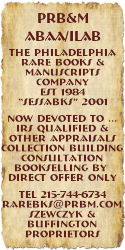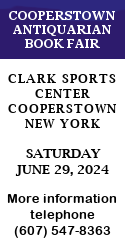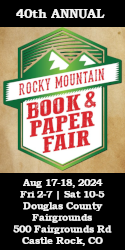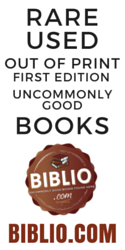Fine Reading Instruments
About the middle of September, Swann Galleries will have its first-ever auction of Fine & Vintage Writing Instruments. I’ve seen the illustrated catalogue and a fine one it is – mostly of older, fancier, and certainly more expensive fountain pens than the ones I used when growing up in the 1950s.
I never really thought much about them at the time because except for the free Coca Cola advertising pencils we were given at the beginning of every school year, fountain pens were for the big kids who were allowed to use them only after learning how to not make a general mess of things. At about that time ball point pens came along and were famously promoted for their ability to be used when writing under water, but since most of our classes were on dry land, I think the advertising pitch went largely untested.
I think I first grew to appreciate fountain pens because of being bothered by the annoying tendency of ball point pens to skip – which many of them still do. The first fountain pens I remember buying as a student were Esterbrooks, retailing for around $1.98 I believe. They came in variously colored, mostly marbled barrels and caps – mine are in shades of blue, green, and brown – and with nibs ranging from very fine to broad. The one I currently use to make out checks and write the occasional personal letter has a #2668 nib, my favorite. It’s a bit on the broad side which makes for more comfortable writing and it holds up a lot better under hard use – with my heavy hand more finely tipped nibs eventually break off, turning smooth, effortless writing into something more like scratching paper with an ice pick.
Fountain pens are filled with ink in several ways, most commonly with a rubber bladder that uses a small lever on the side of the pen to create a vacuum that draws ink from the bottle. Others use a plunger to accomplish the same purpose, and later on pen manufacturers figured out they could make more money selling ink by packaging it in small, generally non-refillable plastic cartridges. Except for one cartridge-type pen that I acquired by accident, all of my pens are filled from bottles of ink that are still available from better office supply stores.
My favorite ink color is royal blue but I also have black, blue-black, green and red, mostly in small bottles. On a nearby shelf with other supplies are two large quart-sized bottles of Sheaffers’s Skrip (one in the original box) with bakelite caps that pour ink from a side spout with its own cap that unscrews. I believe these were generally used by schools for refilling ink wells in students’ desks or in Cratchit-type office situations – like the one I’ve tried to create for myself as an aesthetic balance to the spread-sheets and other computer-based applications we work with nearly every day. Incidentally, does anyone know if the large bottles of Sheaffer’s Skrip came in any color other than blue-black?
Just to be clear – my own cache of fountain pens should in no way be dignified by the word collection. Mostly they’re jumbled together in two shallow boxes in the middle drawer of my desk, and those that don’t fit are loosely scattered among nearby papers. Besides the old reliable Esterbrooks, there are Parkers and others with names like Tuckersharpe, Wearever, Royal, an inch-thick novelty pen from Japan, and some that I can’t identify. In short, a modest working assortment of Fords and Chevys compared to the Rolls and Bentleys of the pen-collecting world.
As you’d expect, a relatively new literature has grown up around vintage fountain pen collecting, including Schneider & Fischler’s Illustrated Guide to Antique Writing Instruments and books by Jonathan Steinberg, Paul Erano, Glen Bowen and others. I don’t actually own any of these books but after I have a look at the Swann catalogue, I may be tempted. And even though I know next to nothing about fountain pen collecting, I do know that in order for them to remain in good working condition they should be used from time to time, even if only kept filled with ink (or water, if not in use) so the bladders won’t dry out.
An important difference (you decide whether it’s an advantage or a disadvantage) between writing directly on paper and writing with a computer is that the cost of paper and relative difficulty of correcting mistakes or rethinking what’s already been written by hand encourages writers to think longer and harder before putting pen to paper. Having to think more carefully really means exercising your short-term memory skills so you can remember and visualize an entire train of thought extending for more than a few sentences before writing it down. In Mozart’s day paper wasn’t cheap – do you suppose that was one of the factors that influenced the way he composed?
I don’t know if any of this bears comparison to the world inhabited by book collectors and bibliophiles, but some of the books in my own modest collection of fine reading instruments are documented in BAL, Sabin, Evans, and various author and subject bibliographies. And, if I were pressed to make just one comparison, I’d say that reading a book on an e-reader, instead of traditional paper and cloth format, is a bit like writing with a Bic ballpoint instead of a good fountain pen, even though both suit the purpose on a utilitarian level. (I do admit that Pilot G-2 gel pens do a fairly good job and are comfortable to use – the problem is they smear easily, especially on glossy paper, and refills cost more than the pens themselves so they’re usually thrown away after running out of ink, making it unlikely they’ll ever qualify as auction material).
And there’s yet another interesting difference between e-readers and fine reading instruments that’s just beginning to make the news. Are you old enough to remember when civil libertarians got their shorts all in a knot over the potential for government snooping through public library records to find out what kind of subversive books people might be reading? That surveillance capability has been drastically improved (is that the right word?) according to recent reports – apparently, purveyors and lenders of electronic texts are now able to not only maintain records of what books you read, but also how long it takes you to read them, when you turn the page, how much time you spend on each page, the pages you refer back to, etc. The market research potential is amazing and beyond the wildest dreams of Mad Men from just a few years ago.
I think it a conclusion worthy of “Obvious Man” (the fearless super-hero occasionally appearing in Non Sequitur) that a decent case could be made that the proliferation of hand-held electronic devices, especially when used in conjunction with cloud computing, is gradually making it easier to peer into people’s lives in a manner that will be of great service to government and business interests.
Some of you have already captured the irony of that last sentence. The QR code (QR stands for Quick Response) that appears in the masthead on page 3 for the first time, gives people with phone scanners access to a URL – in this case the page on the Amazon website that lets them instantly subscribe to BSM and charge it to their credit cards. The trade-off in allowing for tracking and analytics (current buzz words in the data mining industry) is that you’ve done little more than reveal your interest in fine reading instruments and publications that support them.
*
What a roller coaster of a gardening year it’s been! I must confess though, that I’ve spent some of my evening gardening time watching a few of the Olympic events that are taking place at the moment. My main interest is in the swimming bits, since as a swimmer and former lifeguard I used to do a lot of it myself. I’m amazed by the proliferation of competitive events and by some of the seriously proposed new ones – rope jumping, frisbee, synchronized dog-walking? If they can sell the tickets, why not?
In any event at the moment we’re still in an extended dry spell, but nothing like the near drought conditions in other parts of the country. Because we depend on our well, watering of veggies and flowering plants is done sparingly by a modified drip method – directing a hose with very reduced water flow to individual plants for periods ranging from ten to thirty seconds each. It sounds tedious and slow, but actually takes less time than you’d think – more efficient and effective than a soaker hose.
The past couple of years having been on the wet side, with tomatoes succumbing to blight and all kinds of squash being done in by squash-vine borers, so this year’s hot dry weather may be the reason most vegetables seem to be healthier and blight-free – for the moment. But that could change any day, since the zucchini that has been producing like zucchini is supposed to, is beginning to wilt. Backyard vegetable gardening is as local as it gets when it comes to the currently-hip “locovore” movement – more on this next spring.
And because of the dry weather during most of July our dahlias are a few weeks behind with only scattered blooms, but recent rainfall has given some promise that they will soon be producing in full force as they have for many years. One person in the area actually took advantage of our offer of free surplus dahlia tubers this past spring – I hope we can do the same next year.
Each year it seems that the list of flowering annuals that seed themselves successfully gets a bit longer. Alyssum, cleome, cosmos, moon flower (aka datura or angel trumpet), and nasturtium are all plants that we’ve grown for a long time, and they germinate with such profusion in the spring that most of the seedlings have to be treated like weeds and thinned out drastically – especially alyssum, cosmos and cleome. If you know of any others, we’d love to hear from you.
As for the 2016 Olympics, why not a gardening-related event? Maybe a 4 x 100 bean-picking relay with points deducted for pods more than 4 inches left hanging.

























